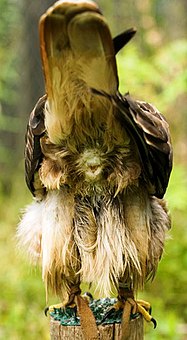Cloaca

In zoological anatomy, a cloaca is the posterior opening that serves as the only such opening for the intestinal, reproductive and urinary tracts of certain animal species. The word comes from Latin, and means sewer. All birds, reptiles, and amphibians possess this orifice, from which they excrete both urine and feces, unlike placental mammals, which possess two separate orifices for evacuation. Marsupials and monotremes also possess one (in marsupials and a few birds, the genital tract is separate). In contrast, each individual among most species of placental mammals and bony fishes has, in lieu of a cloaca, a specialized opening for at least one of these tracts. This is one of the features of marsupials and monotremes which suggest their primitivity, as the amniotes from which mammals evolved possessed a cloaca, and the earliest animals to diverge into the mammalian class would likely have had this feature too.
In birds the cloaca is also referred to as the vent, and among falconers the word vent is also a verb meaning "to defecate". Excretory systems with analogous purpose in certain invertebrates are also sometimes referred to as "cloacae".
Birds also reproduce with this organ; this is known as a cloacal kiss. Birds that mate using this method touch their cloacae for only a few seconds, sufficient enough time for sperm to be transferred from the male to the female.[1] The reproductive system must be re-engorged prior to the mating season of each species. Such regeneration usually takes about a month. Birds generally produce one batch of eggs per year, but they will produce another if the first is taken away (they have the ability to produce more). For some birds, such as some species of swans and ducks, the males do not use the cloaca for reproduction but have a phallus.
One study has looked into birds that use their cloaca for cooling (see Urohydrosis).[2]
The cloacal region is also often associated with a secretory organ, the cloacal gland, which has been implicated in the scent marking behavior of some reptiles, amphibians and monotremes.
Some turtles, especially those specialized in diving, are highly reliant on cloacal respiration during dives. [3] They accomplish this by having a pair of accessory air bladders connected to the cloaca which can absorb oxygen from the water. [4][5] Sea cucumbers also extract oxygen from water in a pair of 'lungs' or respiratory 'trees' that branch off the cloaca just inside the anus.
There are also a variety of fishes, as well as polychaete worms and even crabs, that are specialized to take advantage of the constant flow of water through the cloacal respiratory tree of sea cucumbers while simultaneously gaining the protection of living within the sea cucumber itself. At night many of these species emerge from the anus of the sea cucumber in search of food. [6]
Humans
Human beings only have an embryonic cloaca, which is split up into separate tracts during the development of the urinary and reproductive organs. However, a few human congenital disorders result in persons being born with a cloaca, including persistent cloaca and Sirenomelia (mermaid syndrome)
Notes
- ^ Lynch, Wayne (2007). "Chapter 5: Family Life". Owls of the United States and Canada. JHU Press. p. 151. ISBN 0801886872.
- ^ Journal of Experimental Biology 210, 0i (2007) by Yfke Hager
- ^ Australian Government - Department of Environment and Heritage - Fitzroy Tortoise
- ^ University of Wisconsin-La Crosse - Zoo Lab - Chelonians
- ^ Victorian Herpetological Society - Caring For Australian Freshwater Turtles In Captivity
- ^ Aquarium Invertebrates by Rob Toonen, Ph.D.
